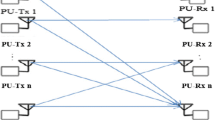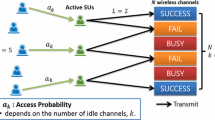Abstract
In this paper, we consider the spectrum sharing Cognitive Radio (CR) system, wherein Single-Input Multi-Output (SIMO) cognitive fading channel is assumed. Subject to the average interference constraint of primary user, the ergodic capacity of cognitive user involving joint beamforming and power control is analyzed. We derive the optimal joint beamforming and power control strategy and deduce the general integral expression for ergodic capacity. Furthermore, under different channel fadings including Raleigh fading, Nakagami-m fading and Lognormal shadowing fading, the specific expressions of ergodic capacity for SIMO cognitive channel are exhibited. Most of the expressions are presented in closed-form or with some special integral functions. Large amount of simulations are conducted to corroborate our theoretical results.
Similar content being viewed by others
References
Spectrum policy task force, Federal Communications Commission, ET Docket no. 02-135, Tech. Report, Nov. 2002.
S. Haykin. Cognitive radio: brain-empowered wireless communications. IEEE Journal on Selected Areas in Communications, 23(2005)2, 201–220.
M. J. Marcus. The underlay/overlay controversy. IEEE Transactions on Wireless Communications, 14(2007)5, 4–5.
F. Rashid-Farrokhi, L. Tassiulas, and K. J. Ray Liu. Joint optimal power control and beamforming in wireless networks using antenna arrays. IEEE Transactionss on Communications, 46(1998)10, 1313–1324.
A. Yener, R. D. Yates, and S. Ulukus. Interference management for CDMA systems through power control, multiuser detection, and beamforming. IEEE Transactions on Communications, 49(2001)7, 1227–1239.
M. Schubert and H. Boche. Solutions of the multiuser downlink beamforming problem with individual SINR constraints. IEEE Transactions on Vehicular Technology, 53(2004)1, 18–28.
M. H. Islam, Y. C. Liang, and A. T. Hoang. Joint power control and beamforming for secondary spectrum sharing. Proceedings of IEEE Vehicular Technology Conference, Baltimore, Oct. 2007, 1548–1552.
L. Zhang, Y. C. Liang, and Y. Xin. Joint beamforming and power allocation for multiple access channels in cognitive radio networks. IEEE Journal on Selected Areas in Communications, 26(2008)1, 38–51.
M. H. Islam, Y. C. Liang, and A. T. Hoang. Joint power control and beamforming for cognitive radio networks. IEEE Transactions on Wireless Communications, 7(2008)7, 2415–2419.
A. Ghasemi and E. S. Sousa. Fundamental limits of spectrum-sharing in fading environments. IEEE Transactions on Wireless Communications, 6(2007)2, 649–657.
L. Musavian and S. Aissa. Capacity and power allocation for spectrum-sharing communication in fading channels. IEEE Transactions on Wireless Communications, 8(2009)1, 148–156.
X. Kang, Y. C. Liang, and A. Nallanathan. Optimal power allocation for fading channels in cognitive radio networks under transmit and interference power constraints. Proceedings of IEEE ICC, Beijing, May 2008, 3568–3572.
X. Kang, Y. C. Liang, A. Nallanathan, et al.. Optimal power allocation for fading channels in cognitive radio networks: ergodic capacity and outage capacity. IEEE Transactions on Wireless Communications, 8(2009)2, 940–950.
P. Wang, X. Chen, S. D. Zhou, et al.. On ergodic capacity of spectrum-sharing systems in fading channels. IEICE Transactions on Communications, E92(2009)5, 1904–1907.
L. Musavian and S. Aissa. Fundamental capacity limits of cognitive radio in fading environments with imperfect channel information. IEEE Transactions on Communications, 57(2009)11, 3472–3480.
R. Zhang, S. G. Cui, and Y. C. Liang. On ergodic sum capacity of fading cognitive multiple-access and broadcast channels. IEEE Transactions on Information Theory, 55(2009)11, 5161–5178.
B. D. Liu, R. Q. Zhao, and G. Wang. Uncertain programming with applications. Beijing, Tsinghua University Press, 2003, 62–64 (in Chinese). 刘宝碇, 赵瑞清, 王刚. 不确定规划及应用. 北京, 清华大学出版社, 2003, 62–64.
S. Boyd and L. Vandenberghe. Convex Optimization. Cambridge, U. K., Cambridge University Press, 2004, 253–256.
N. C. Beaulieu and Q. Xie. An optimal lognormal approximation to lognormal sum distributions. IEEE Transactions on Vehicular Technology, 53(2004)2, 479–489.
Author information
Authors and Affiliations
Corresponding author
Additional information
Supported by the National Basic Research Program (973) of China (No. 2009CB320400), the National High-Tech Research and Development Program (863) of China (No. 2009AA01Z243), the National Natural Science Foundation of China (No. 61072044), and the Natural Science Fund of Jiangsu Province (BK2009056).
Communication author: Yang Yang, born in 1983, female, Master.
An erratum to this article can be found at http://dx.doi.org/10.1007/s11767-011-1003-0
About this article
Cite this article
Yang, Y., Wang, J., Wu, Q. et al. Ergodic capacity analysis for SIMO cognitive fading channel in spectrum sharing environment. J. Electron.(China) 27, 677–685 (2010). https://doi.org/10.1007/s11767-011-0493-0
Received:
Revised:
Published:
Issue Date:
DOI: https://doi.org/10.1007/s11767-011-0493-0




